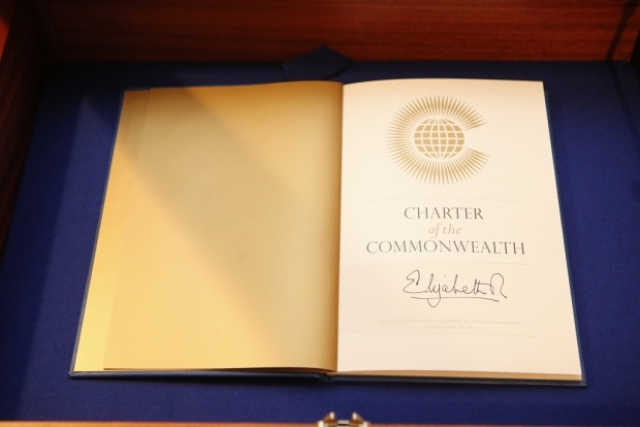 Photo: The Commonwealth Secretariat.
Photo: The Commonwealth Secretariat.
[This is an excerpt from a research article appearing in the current edition of The Round Table: The Commonwealth Journal of International Affairs.]
Several of the values expressed in the Charter of the Commonwealth were breached in the case of President [Mohamed] Nasheed, both before and after the Perth CHOGM. Without a Commissioner to give ‘teeth’ of some kind to the Charter and impetus to the Commonwealth association and its office-holders and institutions, the language of the document is largely hortatory and formalistic. The EPG was anxious to move beyond this. Sadly, it must be admitted that we failed to persuade CHOGM to do so. It might be said that, if a commissioner had been created and appointed, there would have been little more than a voice in the wilderness and the ritual of condemnation and emphatic findings. However, sometimes the provision of a respected voice can be important to reassure victims of abuse and encourage others to provide protection and an example. The office of Ombudsman, based on a Swedish model that is wholly investigatory and limited to non-binding recommendations, has spread to many Commonwealth countries since the 1960s. Depending on the qualities of the appointee, the lack of a power of enforcement can sometimes be a strength rather than a weakness.
Evaluation: The officials who laboured on preparing the draft charter for the Heads of Government of the Commonwealth made a number of improvements, when compared with the EPG draft. It is proper for me to acknowledge these:
- The layout and presentation of the Charter of the Commonwealth, as adopted, is clearer than the EPG draft. The expression of the 16 Commonwealth Values and the bold headings by which these values are identified and presented allow the reader much more easily than in the EPG draft, to perceive the core foundations to which the Charter dedicates the Commonwealth. Substantively, most of the same concepts are mentioned in the EPG draft; but without the same clarity and simplicity;
- In the Charter as adopted, there are only two Aspirations whereas in the EPG draft there were 14. A number of matters which the EPG assigned to Aspirations are now treated as falling within the Values to be defended by the Charter. This appeared to be a desirable development. But it could reflect the view of the officials that the Values were themselves but Aspirations. And hence that the distinction between Aspirations and Values may have been viewed as insignificant. This would not be a correct view, consistent with international human rights law and practice; and
- In several expressions of the Values in the Charter, as adopted, there has been a strengthening of the language of the EPG draft, which is to be welcomed. For example, in the specific Value of ‘Human Rights’ the following appears [CVIIB]:
“We are implacably opposed to all forms of discrimination, whether rooted in gender, race, colour, creed, political belief or other grounds.”
This assertion is considerably stronger than the language of the EPG draft which was founded on the UDHR [EV.5B]. Moreover, whereas the EPG’s Value 5, of ‘Human Rights’, together with Values 6 and 7, assert belief in particular aspects of human rights and equality, in dealing with discrimination, the EPG draft [EV7] rather more weakly expressed as the ‘belief’ of the Commonwealth in ‘tolerance, respect and understanding among all peoples in the diverse nations of the Commonwealth’. The EPG draft [EV 7.3] ‘acknowledge[s] that unjustifiable discrimination against individuals or groups impedes the attainment of the values of the Commonwealth and demands proper correction and redress’. However, this is not as strong as the Charter’s broader assertion of implacable opposition to ‘discrimination on other grounds’. It avoids the ambiguity of ‘unjustifiable’ discrimination expressed in the draft.
Drawing a distinction between ‘unjustifiable’ (and by inescapable inference ‘justifiable’) discrimination is an approach that the Charter of the Commonwealth, as adopted, does not take [CVIIB]. This is also an improvement both in drafting and in substance. So is the emphatic commitment on the adopted Charter to ‘equality’ [CVIIA]. This is a precious provision which I was not sure in the deliberations of the EPG that either the EPG or CHOGM would accept in terms. Yet CHOGM did, proving once again the importance of courage and principle in the role of those who draft international instruments of every kind. Timidity can be seductively attractive for those who underestimate the forces that sometimes combine to uphold principle and embrace universal human rights. Whilst the EPG pushed the Commonwealth in the correct overall direction with its draft charter, it seems clear that the untold story of the deliberations of the officials of the Commonwealth, meeting at Marlborough House, sometimes proved wiser and bolder than the EPG’s Draft had dared to be.
The omission from the Charter of the Commonwealth of the historical features of the evolution of the Commonwealth, mentioned in the Preamble to the EPG Draft [EP1–5] suggests that the officials and CHOGM were disinclined to refer to the gradual historical movement of the Commonwealth from notions of ‘imperial dominion over our nations’ to notions such as freedom, independence and universal human rights. This historical narrative, explaining the context of the Values and how they emerged over time, is completely missing from the Charter, as adopted. Perhaps this indicates that, even today, 50 years after independence, the newer members of the Commonwealth, closer to their independence struggles, are less willing that the old Dominions to concede that the history of the British Empire was one of gradual evolution from autocracy to fundamental rights.
Michael Kirby was a member of the Eminent Persons Group on the Future of the Commonwealth of Nations (2010–11) and a Justice of the High Court of Australia (1996–2009).



